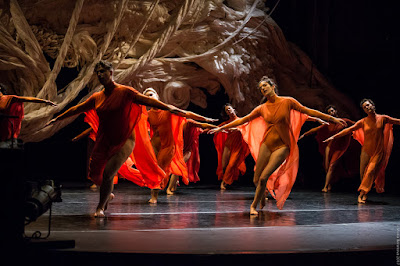 |
| Video installation of David Michalek's SlowDancing/TrioA at Danspace Project (photo: Lily Cohen) |
No to spectacle. No to virtuosity. No to transformations and magic and make-believe. No to the glamour and transcendency of the star image. No to the heroic. No to the anti-heroic. No to trash imagery. No to involvement of performer or spectator. No to style. No to camp. No to seduction of spectator by the wiles of the performer. No to eccentricity. No to moving or being moved.
--Yvonne Rainer's No Manifesto
Okay, no glamour, maybe, but I am completely seduced by the wealth of physical energy and concealed/revealed information streaming through David Michalek's slowed-down video interpretation of Yvonne Rainer's Trio A (1966), here and now at Danspace Project spanning three, large suspended video screens and performed by a succession of 46 soloists. Pat Catterson, a member of Rainer's Raindears troupe, coached performers in the tricky subtleties of Rainer's doing without DOING! For example, if you reach down as if to pick a bottle from the floor, don't make much of it. It's just a bottle and just a reach. No drama.
 |
| David Thomson, one of 46 dancers performing in Michalek's SlowDancing/TrioA (photo: Mark Kornbluth) |
Anyone thinking Rainer's so-called pedestrian movement is, in fact, simple or easy will get a big ol' surprise from Michalek's SlowDancing/TrioA and might even find a kind of virtuosity in it. (If you caught Michalek's original Slow Dancing, in 2007, at Lincoln Center Plaza, you know he knows from glamorous star power, spectacle...and s-l-o-wwwwnesssss.) But, for goodness sake, was Rainer's Trio A ever anything but engagingly focused, confident, exhilarating in execution? No way will she ever not be my anti-hero hero.
Michalek's SlowDancing/TrioA, presented in collaboration with Rainer, continues at Danspace Project tonight and concludes tomorrow evening. Both screenings are available from 6pm to 10pm. Viewers may come and go as they please and can also view Sally Banes' 1978 film of Rainer dancing Trio A.
Admission is free with RSVP recommended. For reservations, visit danspaceproject.org or call (866) 811.4111.
Danspace Project
St. Mark's Church in-the-Bowery
131 East 10th Street (at Second Avenue), Manhattan
(map/directions)















